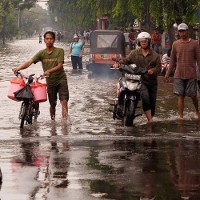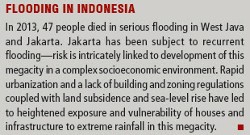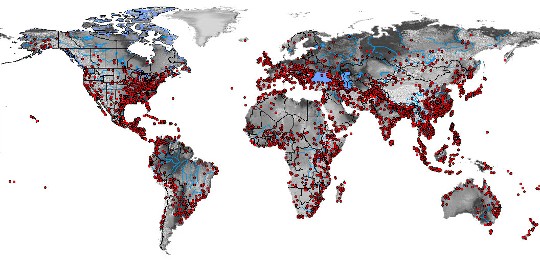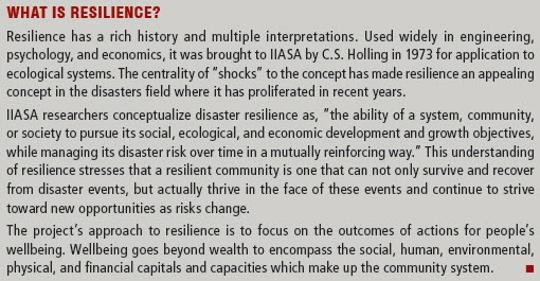12 November 2014
Bouncing forward
Floods are the most devastating natural hazard globally. In order to operationalize, measure, and help build the resilience of communities to floods, IIASA is participating in the innovative Flood Resilience Alliance launched by Zurich Insurance. This extensive research project brings together IIASA’s expertise on risk modeling and systems science with the on‑the‑ground presence of the International Federation of Red Cross and Red Crescent Societies (IFRC), the international development NGO, Practical Action, and the University of Pennsylvania’s Wharton Risk Management and Decision Processes Center.
The Flood Resilience Alliance aims to find innovative ways to reduce risk before a flood strikes. NGO collaborators will use IIASA findings to design and implement interventions to benefit communities. IIASA’s effort, which is truly cross‑cutting, involves three IIASA programs: Risk, Policy and Vulnerability; Ecosystems Services and Management; and Water.
The Alliance is working with communities in Mexico, Nepal, Indonesia, and Peru. As Reinhard
Mechler, IIASA’s scientific lead for the project, explains, “IIASA is designing advanced modeling techniques that are robust, user‑driven, and user‑friendly. The work and findings will not only help communities directly at risk, but also eventually support local, national, and international policymakers, NGOs, and donors worldwide.”
Geographic centers of the more than 3,700 large floods observed globally from 1985 to 2010. Many of these floods hit key loci of socioeconomic development. Future socioeconomic and climatic changes are expected to exacerbate flooding and undermine human wellbeing. Source: Kundzewicz et al. (2014)
The imperative: From risk avoidance to living with risks
The world is facing increasing risks as globalization connects people, economies, and ecosystems. Globally, the number of people exposed to floods each year is increasing at a higher rate than population growth. People are drawn to live on flood plains partly because of economic opportunity. However, it is increasingly recognized that communities cannot totally avoid risks.
To date, the development and the disaster risk management (DRM) communities have relied on a mix of interventions to help communities cope with flooding: “hard” interventions like building a dam or flood evacuation routes and, to a much lesser extent, “smart and soft” interventions like land use planning, insurance, and early‑warning systems.
Flood risk management is dominated by single interventions, many of which fail to meet their objectives because they do not consider the wider socioeconomic system within which they operate. In some instances interventions can even be counter productive for resilience, inadvertently undermining development or actually increasing risk in another way.
The Flood Resilience Alliance is using a participatory and iterative approach to develop sustainable portfolios of interventions that tackle both flood risk and development objectives in synergy.
Says Adriana Keating, IIASA’s Flood Resilience Alliance project manager, "The strategies communities use to pursue their development and wellbeing objectives have a profound impact on risk.
Likewise, the way a community approaches its disaster risk has a profound impact on development and wellbeing. The trick is to get these two working in a virtuous cycle, rather than undermining each other.”
Mechler explains, “A proper understanding of resilience in qualitative and quantitative terms has been lacking in resilience research to date. Arguably, this is why there has been little concrete, measurable progress on the ground. The new initiative focuses on benchmarking and tracking the underlying sources of resilience and the long‑term outcomes.”
For the flood‑prone communities involved in the study, this means shedding light on why one community may fare better than another in the same disaster, despite seemingly identical levels of development and vulnerability.
According to Keating, “With the information and resources acquired in this work, communities will not just be able to bounce back after a disaster. They’ll be able to actually bounce forward in terms of making progress on important development objectives, such as increasing and
strengthening livelihoods, and building requisite infrastructure.”
Further information
Keating A, Campbell K, Mechler R, Michek‑Kerjan E, Mochizuki J, Kunreuther H, Bayer J, Hanger S, McCallum I, See L, Williges K, Atreya A, Botzen W, Collier B, Czajkowski J, Hochrainer‑Stigler S, Egan C (2014). Operationalizing Resilience Against Natural Disaster Risk: Opportunities, Barriers, and a Way Forward. White Paper, Zurich Flood Resilience Alliance.
Kundzewicz ZW, Kanae S, Seneviratne SI, Handmer J, Nicholls N, Peduzzi P, Mechler R, Bouwer LM, Arnell N, Mach K, Muir‑Wood R, Brakenridge GR, Kron W, Benito G, Honda Y, Takahashi K, Sherstyukov B (2014). Flood risk and climate change: Global and regional perspectives. Hydrological Sciences Journal 59(1):1–28 [doi:10.1080/02626667.2013.857411].
Text by Kathryn Platzer
Options Winter 2014/2015
Risk, Policy and Vulnerability Program





